Why is sentiment improving in lithium majors?
One of the earliest uses of lithium was medical. It was used as an anti-depressant. Nowadays, the tables are turned and far and away the largest use is batteries.
As shown below, batteries gained tremendously over other uses of lithium around 2012, and especially since 2016.
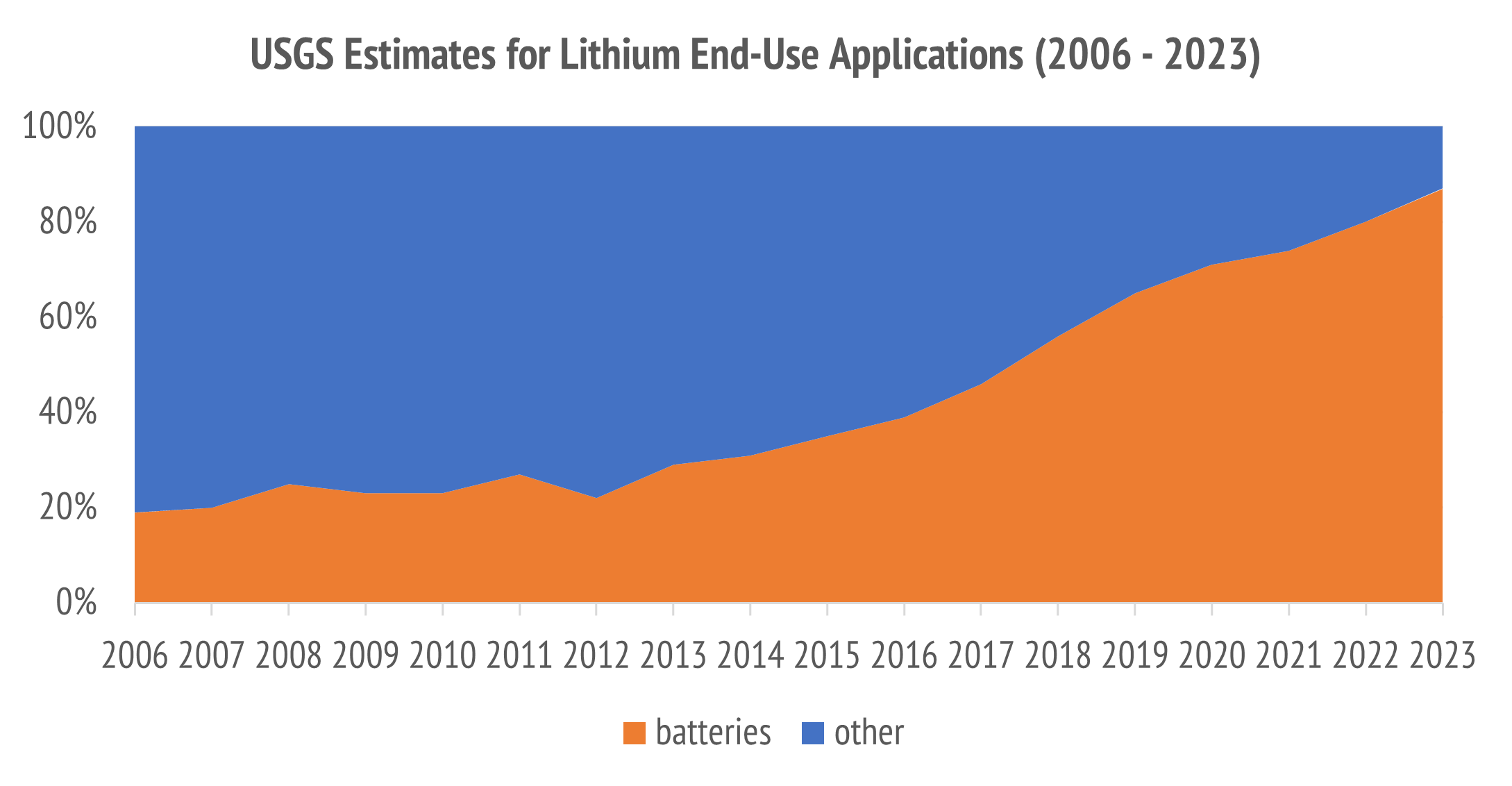
Significantly, Australia retains the largest market share as a source of lithium, through our very large hard rock spodumene resources. The Australian market share of global lithium produced in 2023 was 46.8%, down a little from the peak in 2018, but still robust.
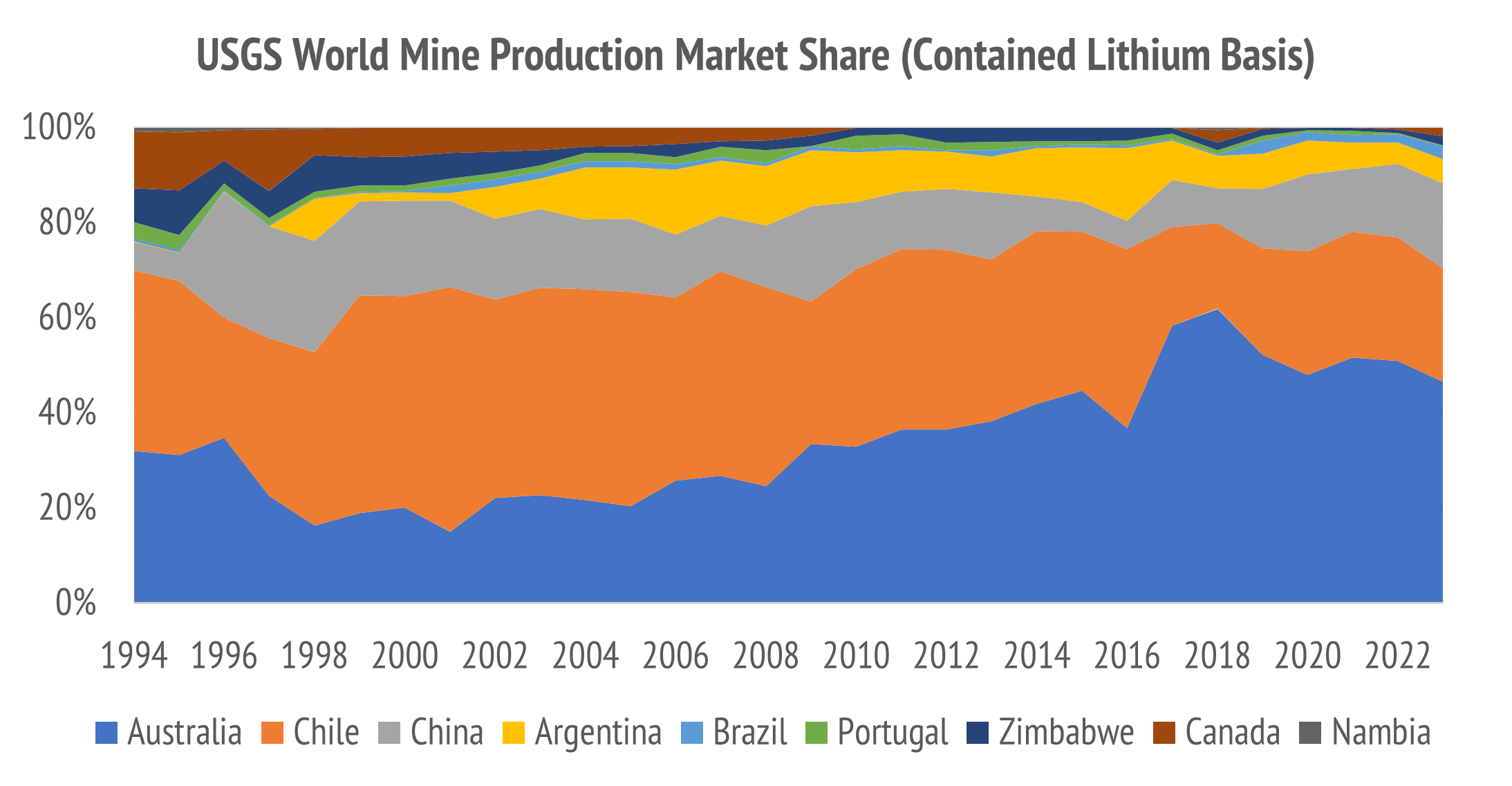
While the lithium price remains volatile, it is clear from aggregate global production data that the demand is on a steep trajectory, especially with the growth in battery gigafactories.
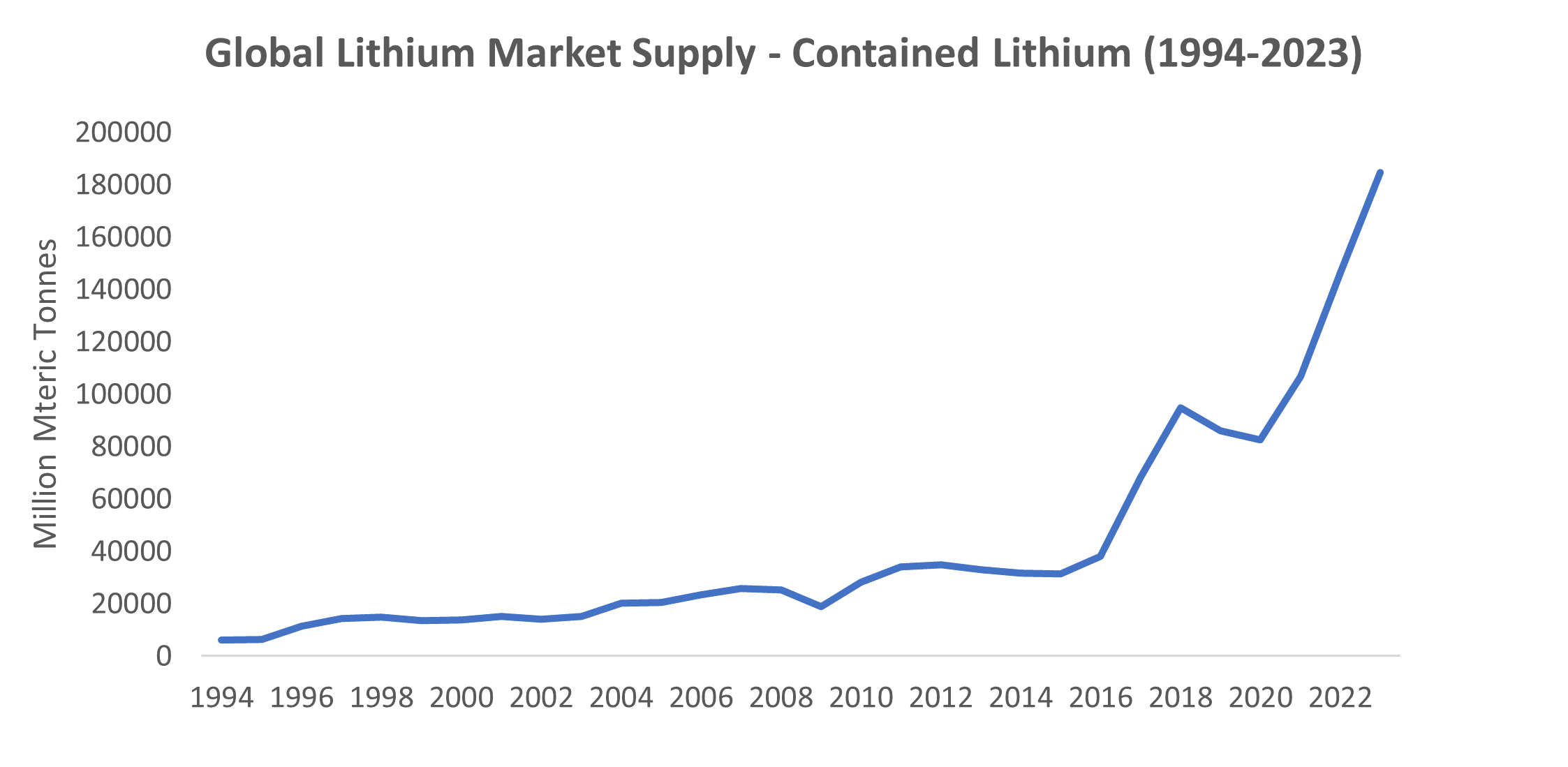
From the look of that chart, it is very clear that the industry underwent a profound change in the demand profile since 2016. That is the year in which the first Tesla gigafactory was built.
The other point of interest us the cyclicality of the year-on-year growth rate. There have been several periods of oversupply, which tended to correct in a period of two to three years. The last big such correction started in 2018 and bottomed around 2020.
Our take is that the regulation of supply and demand primarily happens through the price level. This overshot to the upside from 2021 through mid 2023 following the slump that happened from 2018 through 2020 as a previous overshoot corrected.
What likely matters most now is which firms remain profitable on a cash basis as markets clear and the growth trajectory settles for a year or two. For these reasons, we maintain our focus on established mineral producers, with the explorers likely overcooked at this point.
The Big Five Vertically Integrated Players
In an earlier wire, The lithium gravy train adds an M&A dining car, we covered the M&A boom in emerging lithium developers. In the eight months since, the frenzy culminated with a break in the Liontown Resources ASX: LTR deal due to blocking activity by Reinhart, and a successful deal with the takeover of Azure Minerals ASX: AZS by NYSE: SQM, in partnership with Mark Creasy and Gina Reinhart. The tempo has since slackened with weaker lithium prices.
While many investors have still been chasing emerging developers, this climate, and the cyclical history of lithium markets, suggests a different strategy.
In our view, the derating of the producing majors as proceeded far enough to present very significant long-term value. As I mentioned above, the lithium market has had strong up cycles, lasting 3 to 5 years, followed by minor retrenchments of 1 to 3 years.
We are in such a period now.
The core strategy for the downswing in any commodity market is to focus on the last folks left standing, who are generally those with strong balance sheets at the bottom of the cost curve.
The best hard rock spodumene mine in the world is Greenbushes in Southwest, WA.
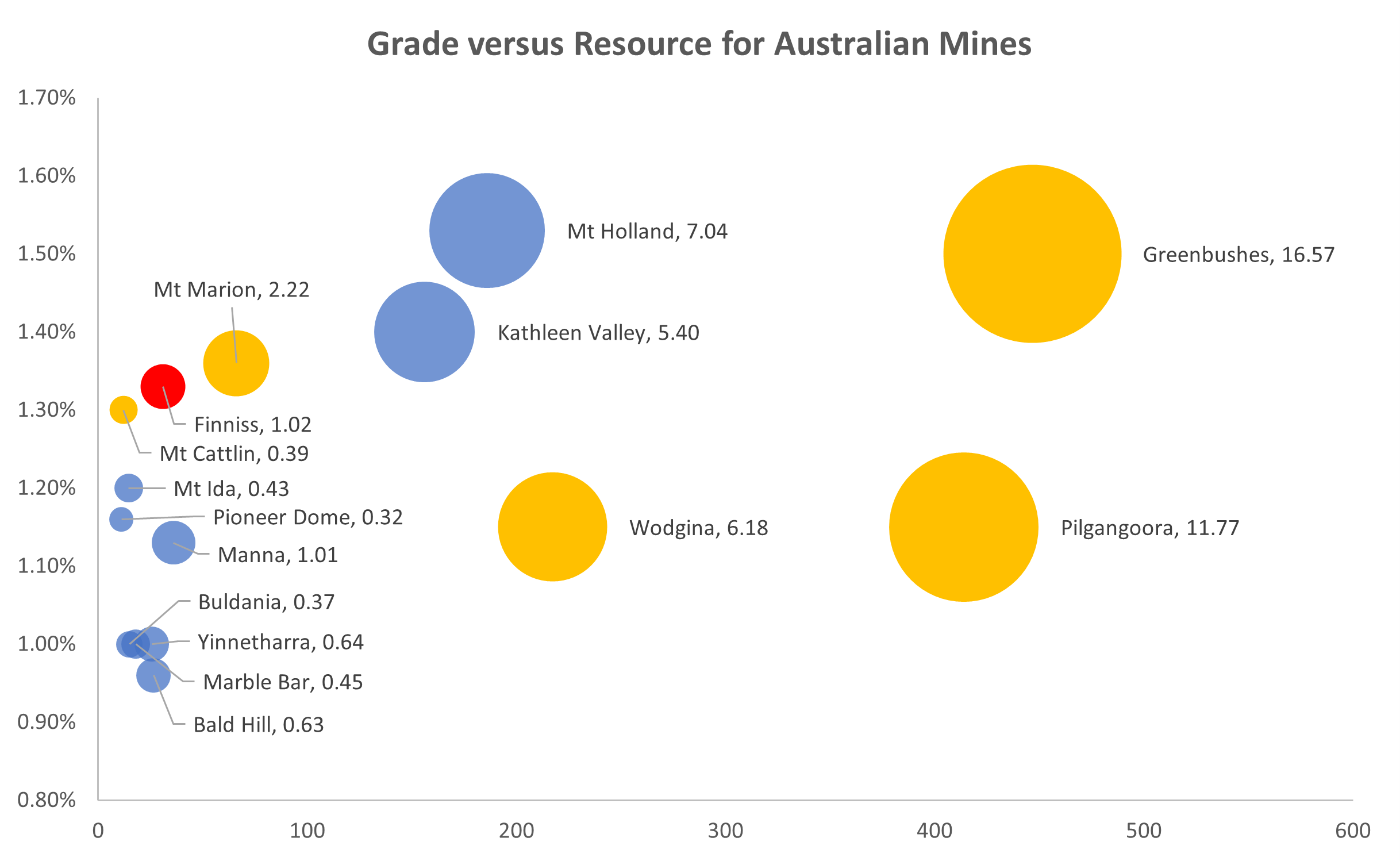
The important thing to understand about lithium is that there are five major global players in the upstream mining and midstream processing and conversion markets.
These are Albemarle NYSE: ALB, SQM NYSE: SQM, Tianqi HKG: 9696, Ganfeng HKG:1772 and the recently merged Allkem and Livent, now listed as Arcadium ASX: LTM. The chart below highlights the relative market capitalisation in USD.
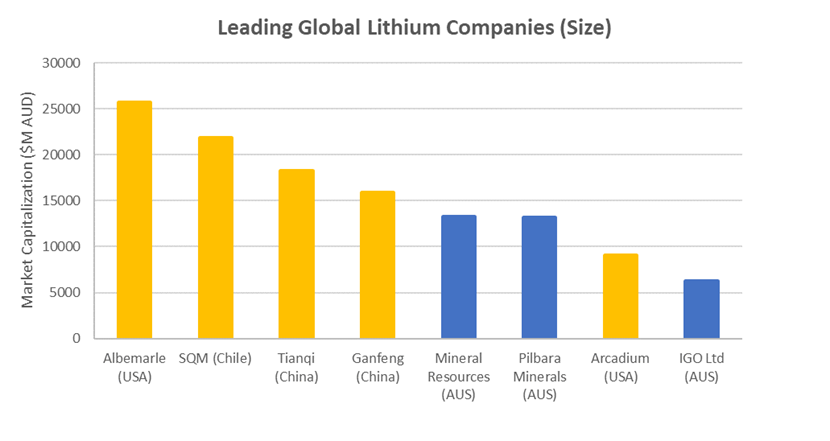
The large local players Mineral Resources ASX: MIN, Pilbara Minerals ASX: PLS, and diversified battery minerals play IGO Ltd ASX: IGO, lurk just outside the top four, ahead of Arcadium.
Firstly, it should be apparent from this chart why Allkem and Livent merged. Secondly, we can see how the pure play Pilbara Minerals is properly the domestic lithium king. The diversified asset base of Mineral Resources sets it apart from the big five, along with IGO Ltd.
To properly understand the likely next steps in the Australian market we need to play the parlour game: "Pin the Mine on the Miner" and hope you did not wind up with a donkey.
Referring back to our diagram of the largest resources, it runs like this:
Greenbushes: 49% Albemarle, 26.01% Tianqi, and 24.99% IGO Ltd (TLEA JV is 51% total)
Pilgangoora: 100% Pilbara Minerals
Mt Holland: 50% SQM and 50% Wesfarmers
Kathleen Valley: 100% Liontown Resources
Wodgina: 50% Mineral Resources and 50% Albemarle
Mt Marion: 50% Mineral Resources and 50% Ganfeng
Mt Caitlin: 100% Arcadium
When you lay the market position out in this fashion, it ought to be clear that the global downstream and midstream electrochemical market is increasingly consolidated.
I have not mentioned the battery chemicals firms, or the Li-ion battery makers. This market is even more consolidated with CATL SHE: 300750 and BYD HKG: 1211 controlling about 50% of the global lithium-ion battery market between them. Some analysts are predicting an erosion of market share as competition builds. The trend has been the opposite.
When we look at the Big Five stock performance, the behaviour has been uniform.
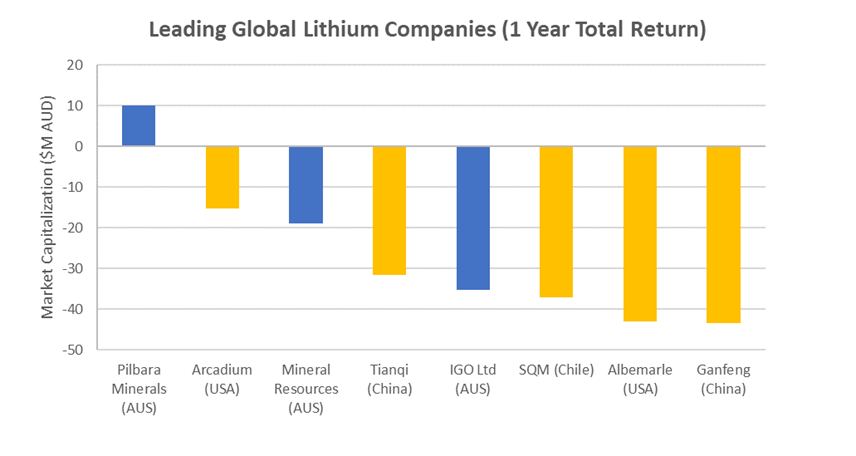
Pilbara Minerals is the only name up over one year. The larger players were marked down the most. This likely reflects an inventory adjustment.
In our view, once there is clear stability in the downstream battery market the character of the M&A activity will likely turn to further industry consolidation. This is the best way to achieve greater price stability in lithium, to help underwrite further industry expansion.
The Global EV Market Potential
The current size of the global vehicle market represents the potential for electric vehicles. The current penetration rate for EVs is only about 7% but is much higher in China. For 2023, the proportion of new car sales which were fully electric has been reported at 25%.
China reports what they call New Energy Vehicle (NEV) sales which includes hybrids. That rate of penetration, for full EV and hybrids, is running around 40%. Of course, as time goes on the rising penetration rate for EVs causes the China growth rate for EV sales to slow down.
This appears to be the reason why many analysts claim that the EV industry is slowing down.
While the growth rate itself is slowing down, the aggregate vehicles sold continues to rise. This is just the math. The year-on-year growth rate slows, but a lower growth rate struck on a larger base means a great deal more EVs sold each year today, than even a few years ago.
Estimates vary, but about 20 to 30% of the value of an electric vehicle is in the battery. The other factor to consider is the mix of vehicles, in respect of battery pack size.
However, all things considered, we need to recognize that China is out in front as a market. Unit sales data from F&I for the top 25 global auto markets shows that emerging markets represent a larger unit sales volume market. China leads with 37.8% share.

The full OIC 2023 sales data will not be available for a while, but the estimated total sales for 2023 is close to 88M worldwide. This amounts to roughly 12% of the above total.
The data reporter EV Volumes puts global NEV sales at 14.1M units in 2023, or which 70% were fully electric vehicles. China volumes are around 5x times those in North America.
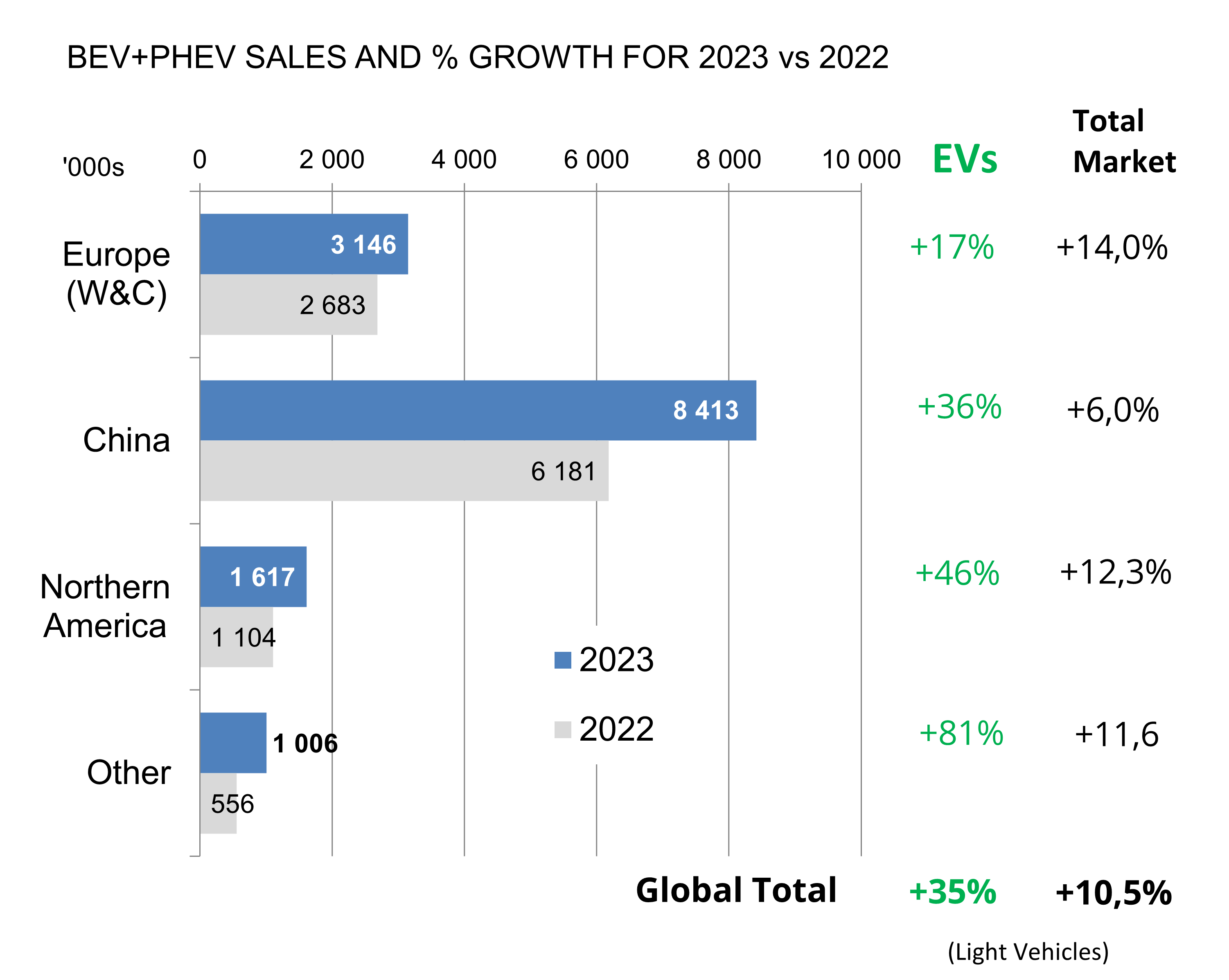
I am not the kind of investor who seeks approval from politicians. I am somebody who tries to be good at my job and to help those for whom I work, my clients.
Given this fundamental difference in motivation, and my own propensity for rational analysis, based on factual inputs, I remain bullish on the global EV market.
What about the "new three" in China versus the Biden IRA in the USA?
It is fashionable for contemporary investors to myopically focus on what happens in the USA. We are supposed to believe that the Biden IRA will "save" Australia from China. This has been at the forefront of domestic discussion about the Critical Minerals Opportunity.
Regular readers of my wires will appreciate that I don't share the bullish attitude of domestic Australian politicians about the USA filling any significant role for our commodities trade.
The USA is a large economy, but whatever it does produce is highly import dependent on the finished components that go into a US assembly line. This has not changed. Despite endless blather from the Australian government, the USA buys no meaningful quantity of rare earths outside of that it uses in petroleum refining catalysts.
I did this topic to death in my wire: Where do the separated rare earths produced by Lynas actually go? In that article I proved that the average annual share of Lynas revenues that is attributable to buyers based in the USA was about 1.5% of their total.
I could do this topic to death for a host of other commodities, but I won't bother.
Anybody who chooses to ignore the data deserves the policy outcome coming their way.
When the data has not changed, I don't change my analytical conclusion.
China leads demand for critical minerals, like lithium, because it dominates downstream manufacturing of the goods that need such minerals.
Australian politicians do not like this fact which is why they continue to pursue industry policies whose central objective enshrines their own public fantasy.
The result will be abject policy failure as surely as night follows day.
China is the market with near monopsony power to be the locomotive.
Sure, we love the USA, but the action there is in digital technology not manufacturing.
Tesla NASDAQ: TSLA may have been the global market leader but lost that crown in 2023 to the Chinese leader BYD HKG: 1211. China has the "new three" industries of solar panels, EVs, and energy storage systems. Western economists are often critical of Chinese government policy on the grounds that they are "not like us". Indeed, they are not.
The Chinese focus on the "new three" industries will likely see China completely dominate the capital goods component of the global energy transition.
You can dislike the fact that China has a considered policy on what to do about the global energy transition. However, this will not change the fact that China is executing to that plan.
In the opinion of this Western investor, it is the West that has a dire and growing problem.
Even with the huge Biden Inflation Reduction Act (IRA) tax credits to new energy investment, we do not believe that the USA will be competitive, on price and quality, any time soon.
There is no meaningful dialogue in Western economies about "what to do" other than to foster protectionism with restraint of trade, tariffs, transfer payments and subsidies.
Folks like me have seen this exact same movie before.
That period was called the 1970s Stagflation.
While my views are not popular, I would urge that investment is not a popularity contest. Wise investors deploy capital where they expect a financial return.
I anticipate handsome financial returns to those investors who deploy capital sensibly to commodities that China, specifically, is buying, and to those energy transition investments for which the capital goods inputs are Chinese.
In short, I am not somebody who is complaining about cheap Chinese solar panels.
I am seeking out those entrepreneurs who are installing solar equipment in a business model based on shaving the large Balance of System (BoS) cost which is local origin.
This attitude has a name: it is called commerce, the idea of making a profit from business activity. I leave the political posturing to those who don't work for a living.
Prognosis for the Lithium sector
The major market value of lithium product is batteries. These comprise 20 to 30% of value in the finished electric vehicle. This is an industry of global scale that is worth chasing.
The reality of our time is that China dominates this market, with high forward demand and a pathway to full penetration of NEVs by around 2040, but possibly earlier.
There is much chatter about a genuine slowdown in EV sales in Western nations. This is real and has happened due to the slow roll out of charging network support, buyer preference for large SUV vehicles, and the appetite for light commercial vehicles, primarily pick-ups.
However, as much as we love the West, the West is not the biggest car market by volume.
Assembly line capacity is driven by unit volume and time to manufacture each vehicle as it traverses the assembly line. Since China has a per-capita GDP of around $12K USD, which happens to be the global average, it will set the average price for a new EV sold.
Analytically, this must be lower than the average price of a car sold into Western markets.
Therefore, what is most likely, is that China will do two things:
- Significantly increase assembly line productivity to meet higher unit volumes.
- Aggressively drive uptake of those cheaper EVs in emerging markets.
From where I sit, it seems that China is executing well on this plan.
This likely means that Western politics will become more toxic than it already is, and we will see greatly increased protectionism to keep Chinese EV imports out.
The West will likely succeed in this goal because it is politically popular.
The natural result of this policy mix is that Western manufacturing will further lose competitive standing, as China proceeds with its present trajectory of yet more factory automation.
Since I am not a politician, I am free to speak the truth of what will likely happen.
China is increasingly finding itself shut out of Western markets.
Since the typical worker in China needs to eat, just as much as their Western counterpart, the ruling Communist Party of China (CPC) will double down on advanced manufacturing.
This is the much-vaunted new productive focus.
In my opinion, this policy will very likely succeed because it is a classic technocratic solution to an obvious economic problem. The issue for China is to develop emerging markets.
For China to replace Western markets it needs to push the production frontier out on volume by a factor of two of three, and down on price by 50 - 80%.
This is the simple math on aggregate purchasing power in the emerging markets.
Only about 15% of the global population live in developed markets.
The other 85% live in emerging markets.
To the Western mind, emerging markets should always remain emerging markets. Since China is not like us, they do not think along these lines. For China to find a replacement for closed Western markets they need the emerging markets to develop.
Every overt policy signal from the CPC has said as much.
Cold hard technocratic economic logic dictates the same conclusion.
I do not make policy in this world, but I can diagnose which policy is likely to work.
Given the basic math, the logic of China hugely expanding the production frontier on volume and down on price makes perfect economic sense. This program will stall if there are not good paying jobs in emerging markets, to earn the money to buy the products.
China is presently copying the 1970s playbook from Japan and doing exactly that. They are building EV factories in Brazil, Indonesia, Hungary and Mexico.
Other nations are free to build plants in the same countries that will accept them. The net of this is that inbound Foreign Direct Investment (FDI) to China is down to zero, while China is raising Outbound Direct Investment (ODI), into other countries.
This is what any rational economist would predict.
This is presently happening across the battery minerals complex.
China invested heavily in Indonesian nickel to lower the price point for higher volumes.
They already did that in cobalt and have long since been doing that in rare earths.
They are now doing that in lithium.
This is an explicit volume strategy to make revenue lost from Western markets with revenue won in emerging markets. Since the buyer operates at a lower price point, this goal is not possible without the conscious pursuit of a volume strategy.
I am a rational investor.
Politics is a profession reserved for those who cannot earn a living by acting rationally. I don't have this handicap, so I only act in a rational fashion.
Whatever squawking may emanate from Canberra, this investor can see the writing on the wall. The winning strategy in lithium is to comprehend the Chinese playbook.
In global commodities trade, China exerts monopsony power.
This means that they are the dominant buyer.
In lithium, the players that are best positioned are those who can face the monopsony buyer and exercise their right to withhold production volume.
That is precisely what happened late last year with Tianqi at Greenbushes.
I won't belabor the point, but everything happening right now in the lithium market is rational. The Big Five are rational players, and so they are going slow on purchasing to clear inventory. We will know when that inventory has cleared because Tianqi will resume its quota.
Some might call this a conspiracy.
If you think it is a conspiracy, then maybe you were never in the hula hoop business carrying massive unsold hula hoops at the end of a local primary school hula hoop boom.
It is the same with lithium.
At this moment, we have not gotten the Tianqi signal on Greenbushes offtake.
I am happy to step in front of that, as all of the signals from the Big Five have lined up around their own clear understanding of how their own market operates. They have chosen to limit offtake below quota when agreements permit, and to curtail expansion plans.
Due to the heavily concentrated nature of this market, that will be enough to balance it.
Among the Big Five we mentioned, our favored two are SQM and Albemarle.
These look like good entry levels to us, although the daily price is volatile.
Our favoured pure play is Pilbara Minerals.
Our secondary play is IGO Ltd, although it is weighed down by the weak nickel market.
Our top target for future M&A is Liontown Resources.
Once the Kathleen Valley mine is built, the suitors will likely be back.
There is no rocket science to these investment views. Lithium is a cyclical mineral with a very strong future growth market.
The cure for the present lower prices is lower prices.
The angst about Chinese EVs being shut out of Western markets simply means that China will switch attention to selling cheaper cars, in greater unit volume, into emerging markets.
The consequent fall in finished Li-ion battery price will drive further demand.
Electric vehicles will experience "good deflation" that benefits the consumer.
I don't make long-term price volume forecasts for lithium, but if I did, I would be upgrading those as a natural consequence of this market condition.
In short, I am a lithium bull once more and I am buying shares in the majors.
Happy investing and good luck finding a politician who can make your country a great one.
Photo by MiningWatch Portugal on Unsplash
5 topics
9 stocks mentioned

